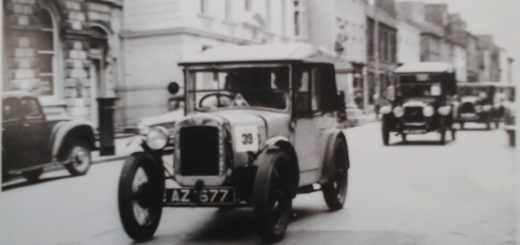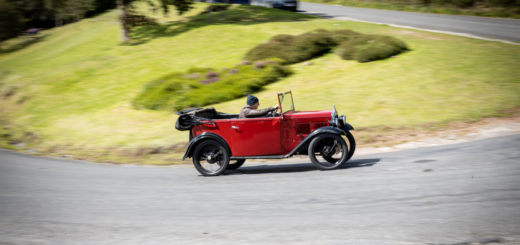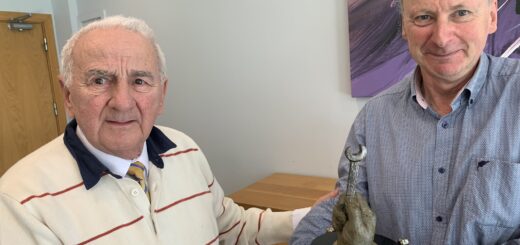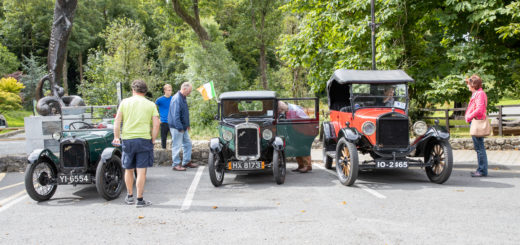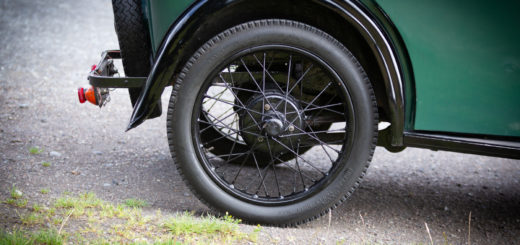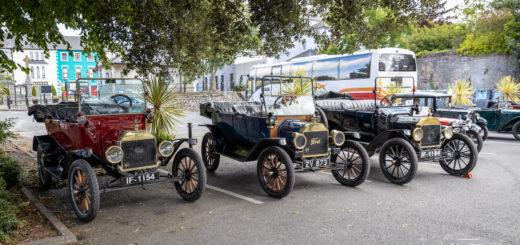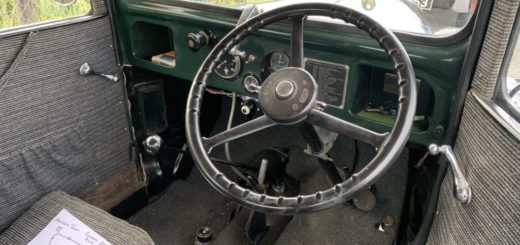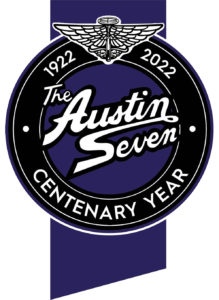Chugs: My Mother’s 1928 Austin 7 Chummy Tourer by Robin Oram
Share this
This old Austin belonged to my parents, Hermione (Dickie) and Arthur Oram, of Churchdown, Gloucestershire. They acquired it in 1938. Mother was working in Devon and had previously owned a Clyno in which she was often seen on the A38, commuting at weekends. In time, she had built up a camaraderie with the AA patrol officers on their yellow motor bike and sidecar combinations; she would wave at them from Chugs and they would delight her by waving back, adding the traditional salute to AA members.
After the War, private cars were a rarity on the roads, and there was a very limited fuel supply. Drivers needed “petrol coupons” which were like gold dust. A journey of any length had to be planned and fuel stocked up for weeks in advance. The car’s three-gallon tank needed a back-up and Mother always carried a two-gallon jerry can full as a reserve. She would never use it all at once, always keeping a pint or two “Just in Case“
I didn’t even know that my parents had a car, until it was announced (in 1946) that we were going to get “Chugs” (Reg. No. FH 5716) out of the barn where she had been laid up during WW II. “Laid up” was too generous; it was obvious that the little car had just been driven into a stable, with fuel in the tank, and not even blocked up or covered.
Getting her going again
Chugs was pushed and rolled to, the Southview garage on Brookfield .Road in Churchdown village (fortunately downhill most of the way) where Mr Booth was to become Mother’s mechanical saviour during the next ten to fifteen years. He proceeded to put Chugs back into order. We don’t know how he managed to find the necessary parts. Possibly, all he needed was a battery, tyres, and plugs and fresh oil, but even those might have been hard to find at that time of real post-war scarcity. To some in Churchdown, Chugs was known as “Mr Booth’s bread and butter“!
Mother cleaned and polished the paintwork, and the brass starting handle, headlamp rims, and radiator cap and badges, and instruments and upholstery; horsehair based with leatherette finish. She always kept Chugs gleaming from that time on.
Being an attractive, valuable, and essential item, the starting handle was usually kept under a seat, out of sight. To use it, the driver would raise the bonnet, open the petrol tap at the tank and then swing the handle, with the free hand reaching in over the radiator to simultaneously “tickle” the carburettor needle and move the throttle linkage to encourage the right mixture. Chugs did have a self-starter, quite a novelty, which worked well most of the time and required the driver’s left foot to engage a switch on the starter motor projecting into the footwell. Of course, the easiest way to start was often just to let her roll, or be pushed, letting out the clutch in second gear when enough momentum was obtained.
After the war-time lay-up, it became clear that fuel in the tank had evaporated; leaving a gungy, treacly deposit which would be stirred up when new fuel sloshed about. Tiny bits of the “treacle” started to appear in the fuel, blocking the fuel pipes and carburettor jet, causing Chugs to sputter and stop frequently, usually in most awkward places. Luckily, Mr Booth found a suitable solvent, then removed the tank and fuel system, cleaned them thoroughly, and put it all back. A big job — but problem solved!
Day-to-Day
Mother was keen on fresh air, as much as possible, and would never put up the folding hood unless the rain had started pelting down and we were all getting wet. Only then would she consent to stop, and we had to pile out, and wrestle with the folding stays and the windscreen clamps until we got thoroughly soaked. This was not amusing to us children, especially if the wind was howling or we were dressed up and going somewhere important, like a school function.
At one such function, a Speech Day as my brother remembers, the weather was kind, and Chugs was cleaned and polished for the occasion. As parents tended to do, some displayed their very newest model supercars, but the largest crowd was the one around Chugs, parked right next to a big new Jaguar.
Mother attracted attention in Chugs, well into the early 1960s. She was known for transporting my brother and his double bass around between concerts, with it resting on his knees in the back, with finger board and scroll neck sticking out of the side (where the removable Perspex window would be).
On one occasion, the main street in front of Cheltenham Town Hall had been suddenly cleared for some dignitary’s short-notice arrival with retinue. All standing vehicles had been “moved on” except for Chugs, conspicuously in the way and whose driver was unaware. As she strolled casually back to the car, thinking how nicely traffic-free the town was today, Mother was spotted by a friendly policeman who just said “Mrs Oram, would you kindly move your little set of wheels, you are holding up the parade.”
Back to the rain, and the windscreen wiper was temperamental. Driven by inlet manifold suction through a long snaky tube, it would slow down suddenly when the driver accelerated, as when overtaking (rare), thus drastically reducing visibility. The driver had to frantically work the little crank on the wiper motor to maintain some visibility; or at worst, fumble with the clamps securing the upper half of the opening windscreen and give it a push so that they could peer through. Looking round the side of the windscreen was another useful ploy.
On family holidays to Cornwall and Devon, Chugs was loaded to the extreme with our camping gear. Tents strapped on to the front mudguard and/or the spare tyre at the back; bedding and buckets and spades inside, food boxes, Primus stoves, spare petrol, and (not least) ourselves, with Mother driving and we three children, Martin, Mitty, and me, aged between 2 and 8 in the front seat. That journey could take 12 or 15 hours, depending on garage stops for necessities or urgent repairs.
Given the work the 747 cc (10.5 h.p.) engine had to do, it boiled frequently, and cooling-down or top-up stops were anxiously awaited relief points on our routes.
End of the Road
Chugs became elderly and needed more and more attention. Mr Booth admitted he could no longer keep her safe and sound, the chassis had been welded up so often where her duties had exceeded her design. My brother, with two school friends, rebuilt her in 1962/63 onto a 1931 Austin 7 chassis, and she continued in service until 1966. In the interim, further expensive repairs had been needed, so reason prevailed, and Chugs was handed over to an enthusiast who would have had the resources to keep her running.
Mother graduated to her aunt’s prewar Morris 8 saloon for a while, then to an open-top Morris Minor named Rufus. Thus, she could re-live the folding-roof-in-the-rain excitement and much more! She kept Rufus running with much the same dedication that she applied to Chugs, until she had to stop driving, in 1992.
Chugs served us well. I learned to drive in her, and we all had lots of fun. Today, she can be seen in a Classic Register website, apparently well restored, but in a shade that differs from her original maroon.
In grateful memory first of all to our mother Hermione “Dickie” Oram, who made this all happen and showed us so much of the natural world on our journeys around England in Chugs.
Acknowledgements
And to my brother and sister, Martin and Mitty, who provided recollections of our travels, and particularly of Martin’s work on the car before my mother parted with it.
To Michael Henderson, a member of the Ulster Vintage Car Club, who heard about Chugs from my daughter, Kate, and asked me to write this article. We enjoyed compiling the memories.
Robin Oram
All rights reserved. Article is copyright of Robin Oram and must not be used in whole or part, without prior permission in writing from the author.
‘Chugs: My Mother’s 1928 Austin 7 Chummy Tourer’ was originally published in the Ulster Vintage Car Club newsletter. Reprinted with author’s permission.


